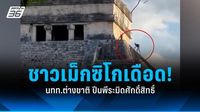On March 20, 2025, a storm of emotions erupted at the Chichen Itza archaeological site when a German tourist climbed the Pyramid of Kukulkan, a sacred structure revered as a symbol of Mayan culture. This incident unfolded during the annual Spring Equinox celebration, a time when locals and visitors alike gather to witness sunlight illuminating the pyramid in a phenomenon called the "descent of the feathered serpent." For many, this date marks the arrival of spring and is steeped in heritage and history.
Local and international tourists had expressed significant excitement regarding this year's festivities, especially following the reopening of the Pyramid of the Sun and Pyramid of the Moon in Teotihuacan just days prior. This holiday season brought an influx of people eager to partake in the rituals associated with the equinox. As gatherings commenced around the vibrant backdrop of Chichen Itza, many grew restless waiting to see the spectacle that has captured imaginations for centuries.
Hidden from view amidst the throngs of excited spectators, the tourist made his way up the steps of the Pyramid of Kukulkan, defying a standing prohibition against climbing the ancient edifice. Witnesses reported seeing him scale the pyramid before security personnel could react. As angered locals shouted for the tourist to come down, the security staff raced up the pyramid to apprehend him.
Ricardo, a security official at Chichen Itza, later stated, "Climbing the pyramids is forbidden since 2008 to protect the structures and our history." His words echo a long-standing concern among preservationists aimed at safeguarding the integrity of these historical landmarks from the reckless actions of visitors. The measure was enshrined into law following numerous incidents where foot traffic led to deterioration of the stonework, and safety assessments indicated that steep and slippery stairs posed a risk to climbers.
Upon being escorted back to the ground, the German tourist faced a hostile reception—furious onlookers surged towards him, and if not for the swift intervention of security, who rushed him away, he likely would have suffered far worse than just the ire of the crowd. The reactions from those present were a mix of outrage and disappointment, with some shouting harshly, demanding repercussions for his actions. A local named Juan explained, "It was part of our ancestral heritage to celebrate by witnessing the first light of spring, but climbing the pyramid is dangerous and disrespectful." His remarks highlight the deep cultural significance of the event and the shared frustration garnered by the tourist's reckless behavior.
The Pyramid of Kukulkan, a magnificent structure rising 30 meters, is one of the most iconic and important remnants of the Mayan civilization and has been designated a UNESCO World Heritage Site since 1988. It represents an intricate intersection of cultural and astronomical knowledge, with its design reflecting the Maya's advanced understanding of astronomy. The pyramid was used for both ceremonial purposes and as a central point for the politics and religion of the civilization at its peak between 600 and 1200 AD.
As the Spring Equinox represents not just the change in season, but also a moment of reflection on life, many find spiritual renewal at the pyramid's base. The importance of the rituals observed on this day is something locals hold sacred, a sentiment echoed in many conversations following the chaotic events of that morning.
Despite the chaotic disruption, the sight of thousands of people gathered at dawn to reverently witness the sun's rays begin to illuminate the ancient stones remains a powerful testament to the enduring allure of Chichen Itza and the history it embodies. Events like these remind both locals and visitors of the need to approach such significant sites with a mindset of respect and preservation.
Authorities have reiterated their commitment to ensuring that such incidents do not compromise the safety of both tourists and the structural integrity of historically significant landmarks. With increased enforcement of guidelines and clearer communication to tourists about the potential dangers and legal repercussions of their actions while visiting these sites, officials hope to prevent further disruptions in the future.
The allure of the Spring Equinox at Chichen Itza remains unmatched, drawing people from all corners of the globe to witness the rebirth of spring amidst ancient histories. Nevertheless, the events of this year's celebration have sparked a new dialogue about the responsibilities carried by all who tread upon these sacred grounds, a conversation sure to linger in the hearts and minds of many long after the equinox sun has set.







